Vanha Alakylä |
|
Vanha Alakylä (Old Downhill Village) was situated on Karelian Isthmus on the left bank of Rajajoki river, also called Siestarjoki by Swedes and Sestra (Sister) by Russians – the natural border between historical regions Karelia and Ingria.
Christianization of Finland began in the middle of XII century on the South-West territories, occupied by Swedes. By the beginning of XIII century the activities of Swedish Catholic missionaries spred to all Suomi lands and part of Häme territories. Swedish expantion produced the repelling reaction of Novgorod The Great, that for long times had it's own political and commertial interests in Finland, that took form of military raids of Novgorod and allied Karelian forces into Finland and Sweden. As a decisive action to stop Swedish influence and make a final ally union Novgorod prince Yaroslav Vsevolodovitch in 1227 "baptized lots of Karelians, almost all of them" into Orthodox church. But at the time Orthodox believers were same as pagans for Catholics and Orthodox baptization did not stop them. In 1293 the new Crusade – this time against Orthodox Christians – started. On the territory of the three captured Karelian Orthodox parishes (Jääskis, Äyräpää and Savolaks) a "second baptization" of Karelians into Catholic church took place. Swedes build a new fortress Viborg (Viipuri). After unsuccessful Novgorod raid on Viborg and several bloody battles in the year 1923 Sweden and The Great Novgorod singed a treaty in Oreshek, in which for the first time Rajajoki River was set as a border between Sweden and Novgorod and also between Orthodox and Catholic Churches. In that a way at the final stages of forming Finnish (Catholic) nation only western Karelians took their part, becoming with a time one of the dialects of Finnish nation. Eastern (Orthodox) Karelians developed as a separate nationality. First written document that mention "the village on Valakila" (Alakylä) belongs to the end of XV-th century. According to 1499-1500 cencus book the village consisted of two living houses and was a part of Valkeasaari (now Stary Beloostrov) region. Till 1470 the region was part of crown lands of Prince of Korela and belonged to Vozdvizhensky Korboselga circuit, Orekhov uezd, Karelian half of Vot pyatina of The Great Novgorod. In 1527 Swedish King initiated Reformation and soon Lutheranism became official religion in Sweden. Even before signing 1617 Stolbovsky Peace Treaty Lutheran Finns from western karelian Viborg and Savolaks regions started to settle on Ingermanland territories, devastated during the long Russian-Swedish war. After signing the Treaty the process became organized and the newcomers were freed from military service. Simultaneously Swedish authorities hardly oppressed Orthodox Karelians, that cause their mass migration to Russian lands. Self-names Savakots (came from Savo) and Äyrämöisets (came from Äyräpää nearby Viborg) were used by newcomers till XIX century, when they were replaced by common name "Russian Finns" or, later, Inkeri – by the historical name of the territory they live in.
The inhabitants of Vanha Alakylä already in the beginning of XX century couted themselfs as common Finns, living on Russian side of Rajajoki. Many of them had relatives on the Finnish side of the river.
Main occupation of both old and new inhabitants of Alakylä was traditional agriculture and cattle-breeding. Rajajoki River served as administrative border between two lens (regions). Newly build in 1628 Lutheran church in Vartemäki served as a center of a parish. After the fire in 1656 parish center moved to Toksova, were, by the time, was built own church. In 1685 St. Peter and St. Paul Lutheran Chapel parish was formed in Valkeasaari. New parish included Alakylä village. During The Northern War some of the inhabitants of Alakylä moved to Konnunselkä (or Konnunkylä) village some two kilometers to the North. From that time it got the name Uusi Alakylä (New Downhill Village). And that is from that times old village became Vanha Alakylä (Old Downhill Village). |
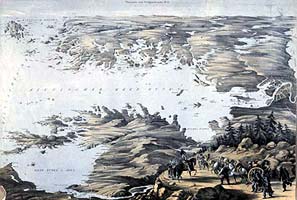 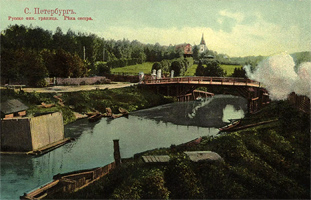 |
|
After the defeat in The Northern War according to 1721 Uusikaupunki Peace Treaty Sweden had to return to Russia Ingermanland and Western Ladoga Karelia which caused big changes in the positions of Lutheran inhabitants. Rajajoki River became an administrative border between Viborg and St-Petrsburg Gubernias (regions).
Settling the new Empire capital (St.-Peterburg) brought to life new occupations for Vanha Alakylä inhabitants, such as delivery to the city of milk products, meat and greens and also a carrier trade. Vladimir Dal dictionary fixes new Russian world "chukhonets" as St-Peterbuger's name for near city Finns. In 1734 the Valkeasaari Lutheran parish branched off Toksova Lutheran parish. In 1763 the new wooden church built in Valkeasaari. In 1811 Viborg region was returned to Finland, that became an Autonomous Grand Duchy of Finland within Russian Empire. Rajajoki River became a border between Autonomous Grand Duchy of Finland and St-Petersburg region. Vanha Alakylä inhabitants got a new very profitable "job" – smuggling different goods through custom border. |
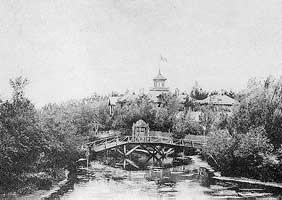 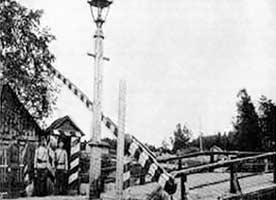 |
|
Vanha Alakylä was a part of Beloostrov (Valkeasaari) volost of St-Petersburg (from 1914 – Petrograd) gubernia.
By the middle of XIX century there were 23 households with 136 inhabitants in the village. On June 29, 1894 the new lutheran church was blessed in Beloostrov (the name has changed to Stary Beloostrov). The church for 850 seats was built by the project of Sankt-Petersburg architects Oskar Tibo-Brinjole and Alexey Vorobyov. In the church was installed the organ of 27 registers, which was in using from 1865 by the St.Catherine lutheran church in the Sankt-Petersburg. |
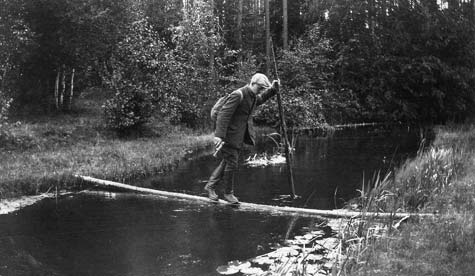 |
|
When Finland became independent, Rajajoki River once again became a state border.
During the bloodshed of the 1918-1920 Civil War in Russia more than 8 000 Finns had to seek the shelter in Finland, where military clashes were finished in May of 1918. Part of the inhabitants of Vanha Alakylä also moved to the Finnish side of Rajajoki River. With strengthening of Soviet power the Finnish-Russian border was closed. Barbed wire fences covered the left shore of the Rajajoki River and contacts of the inhabitants of Vanha Alakylä with Finnish side were stopped. Still the village have it's trace in the Soviet history as the "Rajajoki window" – specially organized by GPU place for illegal crossing the border, that worked within the framework of the special operation "Trest" which purpose was to decoy on the territory of the Soviet state it's political enemies. In 1924 Petrogad gubernia was renamed to Leningrad gubernia (in 1927 – to Leningrad oblast). In 1926 there were 39 farmer houses in Vanha Alakylä. Still existed the Stary Beloostrov Lutheran parish. In 1929 the "elimination of kulaks ('over rich' peasants)" campaign started. As the medium level of life of Russian Finns (about 2-3 cows, 5-6 ships and 1-2 horsed per household), was higher than the Russian average, many peasant families were sent to Siberia with only belongings they can carry themselves. In 1932 the lutheran church in Stary Beloostrov has been closed, but the parish members was achieved its opening seven months after. It has been finally closed in 1935. In the April 1935 Leningrad branch of NKVD carried out a special operation "of clearing the border strip of Leningrad region and Karelia from kulaks and anti-Soviet elements in repression order". The 22-kilometers wide line along the border with Finland was fully "cleaned up" from the inhabitants because they, by the opinion of Soviet State, represented "unreliable contingent" near the border. The "cleaned" Vanha Alakylä village was set to fire by NKVD. In the night of November 30, 1939 Soviet troops crossed the Rajajoki River, starting Soviet-Finnish Winter War, that lasted till March 12, 1940. As the result of the war, the right bank of the Rajajoki River also became Soviet territory. |
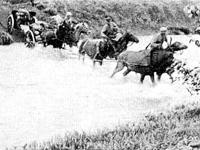  |
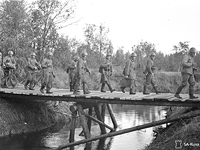 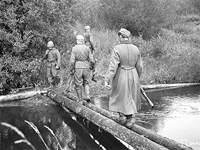 |
| On June 25, 1941 the new Finnish-Soviet war started and on September 2, 1941 the 18th Finnish division under the command of colonel Aaro Pajari cuptured the territory of former Vanha Alakylä village. Front-line soon stabilized some kilometers to the South and did not move till the summer 1944. |
|
The lutheran church in Stary Beloostrov has been burned down in September 1941, when the Soviet artillery set it on the fire, suspecting that in the church was placed the Finnish fire control post.
On June 9, 1944 mass offensive of Soviet army has started on Karelian Isthmus. Positions of the 10th Finnish division (under command of major-general Jussi Sihvo) nearby Beloostrov were broken. However, heavy fire of the artillery, positioned at the rear of the defense line did not allow further offence. About 11 AM nearly 300 Soviet planes attacked the artillery positions near former Vanha Alakylä village and Finnish troops had to retreat to the North. |
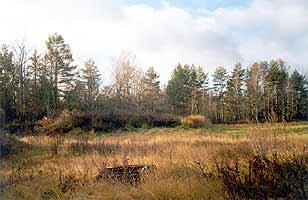  |
|
In October 2000 I hardly found the remnats of nearly 500 years of existance of Vanha Alakylä village hidden in the fields and forest belts.
In creating this page were used materials from Eugeny Balashov book "Karelian Isthmus – the unknown land", part I.
|
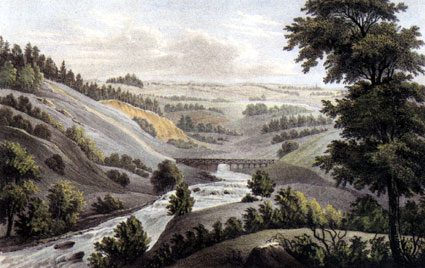
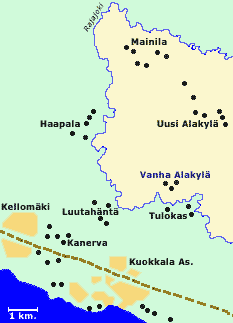 The Finnish nation, descended from Ugro-Finnish Suomi, Häme and Karjala tribes, originated in the end of the first – beginning of second millenium AD. The participation of Karjala tribes in the process, due to their neighbourship and close relations with Novgorod The Great, was rather complicated and dramatic.
The Finnish nation, descended from Ugro-Finnish Suomi, Häme and Karjala tribes, originated in the end of the first – beginning of second millenium AD. The participation of Karjala tribes in the process, due to their neighbourship and close relations with Novgorod The Great, was rather complicated and dramatic.